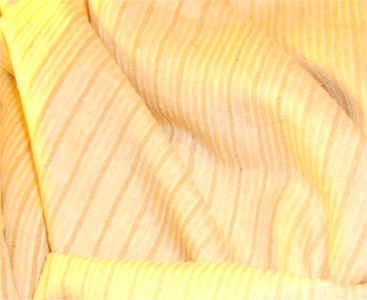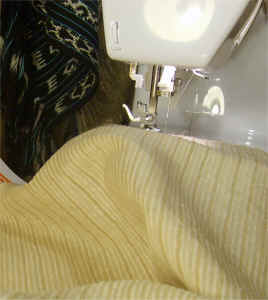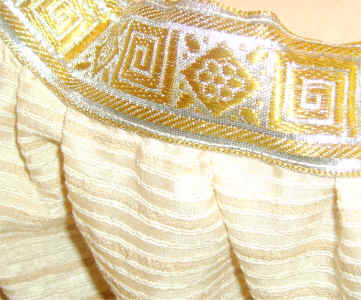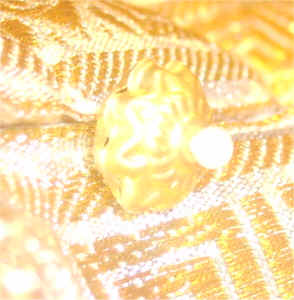![]() The
Romanesque
The
Romanesque ![]()

I have long toyed with the idea of making myself a Romanesque outfit. The beautiful draping of the layers of fabric were so alluring, it was always a must have at some point.
As usual I started with an idea, then researched and made my accessories first. One thing I found increasingly frustrating while researching, is that while there is a wealth of information on the Roman Republic and subsequent Empire, to glean full image of a roman woman's dress at one particular year, or even a 10 year period of this era, or one geographic location, was next to impossible. The resulting outfit is therefore somewhat generic in nature.
As much as I wanted to avoid having things from different eras mixed together, i.e. 1 BCE head dress with 3 CE shoes, it may well happen that way. Admittedly fashions didn't change fast back then, but I am sure there were regional differences that I am unable to account for in making this outfit.
18 August 2007
Finished off my head dress for the ensemble. It is styled to resemble one in the Getty Museum that depicts Aphrodite and Eros. The date on this piece is about 1BCE. I am keeping some of the hollow gold metal beads aside to use on my Chiton.

The earrings I made late last year.
|
|
 |
Encaustic portrait of woman, Getty Museum, early C2 CE |
My Roman inspired earrings using a hook to affix to the ear and garnet drops for the gold bar. |
20 August 2007
Pulled out all the braids, and the rolls of silk out of the shed to iron for the outfit. They should look really spectacular. I have some very special gold fringing for the bottom of the Stola. I also located the gold cord to use for tying the waist.
20 August 2007
Ironed all the material for the outfit. I have a variegated rough silk, in a gold shade for the Chiton, black Thai silk for the Stola, and red wool flannel for the Palla.
21 August 2007
In my copious amounts of spare time, I have finished the Palla. I am pleased with the effect of this very simple item.
The Stola is finished with a gold macramé fringe that was salvaged from a pair of curtains. After this was attached I turned back the silk and attached the braid. Because this garment will possibly be covered by the Palla, the decorative treatment for this garment is at the hem. Also there will be jewels a the neck to add to the over all adornment.
 |
 |
 |
| My Palla of red wool flannel and gold trim. | Applying the knotted fringe to the Stola | The finished edge of the Stola with the fringe and the braid |
The Chiton is the undergarment I have chosen for this ensemble. I want the 'sleeves' to be full length. Call me odd, but I like the idea of covering my arms. For sun protection if nothing else.
 |
 |
| The silk for the Chiton | sewing the Chiton |
Wether it is right or wrong is yet to be seen, I decided to put extra into the body of the Chiton and gather it along the arm openings onto braid. The silk is still rather stiff and needs to soften for it to drape the way I want it to.
 |
 |
| The silk gathered into the braid at the arm openings. | Hollow gold metal beads used to fasten the sleeve. |
It feels odd using so much braid on an outfit. I am not used to so much 'BLING' like this.
22 August 2007
Finished! 1530hrs and the dress is all done. I have a necklace I still want to make to go with it. Now for some photos.
Want to see the finished product? Click here.
The following are extracted from "A Dictionary of Greek and Roman Antiquities by John Murray , London , 1875"
INAURIS - Earrings
Consisting of gems and occasionally glass, worn in pierced ears on either hoops or hooks. It is interesting to not that the hooks faded out of use for many centuries, and the hoop was the favoured method of earrings.
ACUS - needle or pin,
Usually of bronze used for fastening the hair. Much like hat pins of today, but a little sturdier.
ANNULUS - finger rings
Originally worn as seals, they evolved into items of adornment that signified status and were also worn as talisman.
ARMILLA - bracelets or armbands.
Styled as either a cuff or coiled armband. they appear to have always been on a non fastening style.
PERISCELIS - bracelet
A bangle kind of bracelet. A single piece with no opening that slides over the hand onto the arm.
CATELLA or Catena - chains
These were commonly worn by women, either on the neck, or, around the waist; and were used to suspend pearls, or jewels set in gold, keys, lockets, and other trinkets or talisman.
FIBULA - brooch
Consisting of a pin (acus), and of a curved portion furnished with a hook. The curved portion was sometimes a circular ring or disc, the pin passing across its centre.
MONILE - Necklace
The simplest kind of necklace was the monile baccatum, or bead necklace which consisted of berries, small glass beads, semi precious gems, then strung together. A row of drops hanging below alternating between the beads is also occasionally seen. This is very commonly shown in ancient paintings.
The value of necklaces were elevated by the incorporation of pearls and precious stones, which were strung together by linen thread, silk, or wires and links of gold. For this purpose emeralds, or other stones of a greenish hue (smaragdi), were often used. Amber necklaces are mentioned in the Odyssey.
![]() Useful Sites
for recreating Roman Dress
Useful Sites
for recreating Roman Dress
A Dictionary of Greek and Roman Antiquities by John Murray , London , 1875
All
intellectual content, composition, layout, designs and photographs copyright
2003 to Deborah Murray ©
or Mistress Oonagh O'Neill ©.
All Original renaissance art works and artefacts are not copyright to Deborah
Murray, and are shown for educational use only . If you see something
you'd really like to use, please contact
me!